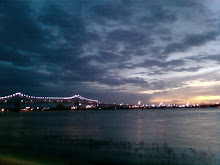One of the negative things about living in the inner city is that one can never find what you need in the easy-cheezy convenient way that a resident of the suburbs can. Such is the final insult of our auto age.
An urban resident often finds that basic services such as grocery stores, banks, pharmacies, etc. are usually located some distance outward in the suburbs, or in the outer extents of the urban core if lucky. Much the same can be said for less essential services such as hospitals and medical centers, movie theatres, video rental stores, restaurants (that are open at reasonable hours), barbershops, specialty stores, and other retail/service offerings.
These types of establishments generally do not locate themselves in inner city areas, for obvious reasons. It is easier to chase customers and disposible income in auto mall land where there is more of both.
Some folks move into an urban area with the idea of reducing their "carbon footprint" and then they find that they must drive more than they used to, just to reach the closest supermarket or drugstore. Oh the irony.
My neighborhood has a small corner grocery store that supplies a large number of basic goods and foodstuffs without having to travel out the Interstate into auto-land, but it's not a good idea to shop there too often if you are on a budget.
It goes without saying that downtown here lacks a full service grocery store, pharmacy, etc. This is not a criticism per se. Downtown as a neighborhood, as in so many other cities, does not have a critical mass of residents and other human activity to support these businesses.
Yet lack of these amenities does not bode well for growing or expanding a downtown residential base. Those people that downtown manages to pull in from the suburbs have to be willing to make the sacrifice of convenience of having every service known to man located just five minutes away on the arterial that feeds the subdivision. It is a price one pays, regrettably, for living in a more fulfilling environment. Few people, when given the trade-off, are willing to do so.
But there are positives, too, to living far from the land of the strip mall and cheep plastic and glass garishness.
Since retail options are distant, it reduces the temptation to spend money, and makes what purchases are conducted rarer and more responsible.
And of course, one is not regaled with the sea of asphalt as a daily fact of life in one's urban experience.
And if you work in or near downtown, your commute becomes a lot shorter, and probably far less congested. Or you find that walking or biking to work becomes an option, and you can dispense with the automobile entirely for commuting purposes.
In the age of sky-high petrol prices, that's always a good thing.
I give a few establishments credit for locating in suitably reasonable places for inner city residents. Family Dollar stores can be found in neighborhoods relatively close to downtown. Unlike other chains I suspect they don't see any stigma in selling merchandise to customers with Black and tan faces.
It is a chicken and egg problem, fundametally. Businesses generally chase customers, but customers don't like to live in areas where they have to make a long trip to reach those businesses, if there are other and more convenient living options available.
It is the real problem of spatial mismatch, notwithstanding anything the academic profession wants you to believe.
19 October 2008
Subscribe to:
Post Comments (Atom)



No comments:
Post a Comment